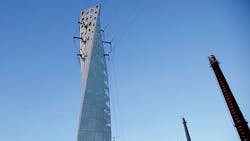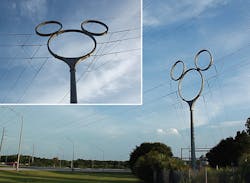Visually Appealing Structures
Over the past 130 years of electricity in America, the attention given to transmission line aesthetics has been mostly an afterthought or, more recently, a process complication necessary to gain public acceptance and secure the required permits for a project. Utility aesthetics have been relegated to playing a public relations role. But how should visual impact tie into the engineer’s numerous responsibilities to public safety, health and welfare?
The engineer must balance competing aspects when designing a transmission line. Three lasting performance characteristics remain once a project is energized: electrical function, structural integrity and aesthetic imprint. While the first two are utilitarian in nature, the last ought to bear a weight of its own. Utility structures have the power to transform landscapes, their impact consumed by the public eye for decades. This provides the impetus for engineers to adopt aesthetics into design.
Visual Impacts
Unlike the self-evident function of roads, bridges and buildings, the function of the T&D industry’s infrastructure is abstract and intangible to consumers en masse. To the average observer, transmission lines and the towers that hold them are static objects, opaque in function and arbitrary in form. The flow of electrical current through conducting lines is a qualitative leap away from that of water or traffic. With power delivery structures, there is no easily discernible relationship between function and form; this fact dynamically changes the way the individual relates to them.
Despite general unfamiliarity with the technical story of how electricity arrives at the average wall socket, consumers are aware of society’s dependence on reliable energy. The threat of a blackout captures immediate attention because the public knows a blackout halts business, cuts off communication and endangers lives. This is why power outages make news headlines.
When critical systems fail, all attention focuses on restoration and for good reason: these lifeline infrastructure services are foundational for civil and national stability. Consumer expectation for reliable electric service increases as quickly as the benefit the service delivers.
As demand for energy accelerates, power delivery infrastructure continues to expand to support load growth, meet reliability requirements and reach new generation sources. The lines that carry power through cities, towns and the countryside are ubiquitous objects of development, giving context to their surroundings. Transmission structures are the iconic reminders of how energy interweaves society.
Everyone has come to expect so much of these lines, yet the general public openly criticizes their visual impact. Power generation and consumption are recognizably important and the public is not as critical of their structures. Since transmission lines lie in the grey area between these two spheres, they are easier targets for criticism.
Aesthetic Considerations
When consumers cannot readily understand the function of complex systems, the general aesthetic of design becomes one of nonimpact: make it smaller, make it easier, make it integrated, make it go away or put it somewhere else. Today, utilities pursue the typical transmission project with this aesthetic of nonimpact, sometimes to painful extremes — poles camouflaged in coniferous foliage spring to mind.
The aesthetic has not always been resigned to nonimpact. Some approaches sought to accentuate the imprint of utility structures on the built environment. A century ago, the introduction of generally available electricity, and the transmission system that brought it to the home, was recognized and celebrated by those lucky enough to be connected to the grid. The transmission structure was a symbol of progress and possibility — literally, power to the people.
In some instances, the dialog about the aesthetic impact on the built environment can overwhelm the technical and economic considerations of a project. Take for example the San Francisco–Oakland Bay Bridge project, which as been called a landmark beset by problems. In a similar fashion, processes in power delivery can focus more on siting, aesthetic impact and public acceptance than on how the line relates to the power grid reliability or performs electrically. But at the end of the day, there is a lasting imprint on the landscape with every installed mile of transmission line and the economics are usually not insurmountable.
Form and Function
Power lines inherently take up aerial space and traverse many linear miles to accomplish their purpose in the grid. Along the way, they cross many properties and geographical features while maintaining the required electrical clearances for physical operation and public safety. These basic functional constraints are significant, and they dominate the size and scale of an overall project. From a visual perspective, the public encounters a transmission line in two primary modes, either as a viewable line segment or as individual structures.
Depending on the design execution, the line segment and its repetition can be distracting and busy, or natural and even graceful. A skillful line designer pays attention to height, color, span length, structure position, community identity and visual repetition of each line segment. Likewise, the design of individual structures should include aesthetic considerations based on architecture when setting the scale, proportion, form and taper of the different structural components.
Traditional transmission structure design must address certain realities to satisfy the laws of physics. Material and manufacturing technologies have grown up with the industry, and there are now many combinations of structure types from which to select for each project. As voltage levels increase, so do structure sizes, to the point that structural options become more limited.
Historically, there have been two primary types of high-voltage transmission structures: tubular poles and lattice towers. In terms of form, traditional poles are solid, straight, vertical elements with multiple horizontal-arm elevations intersecting a column. Traditional towers are airy tapered bodies with lacing elements throughout and a series of pointed arm elevations attached along the superstructure.
While remaining in the realm of traditional design, improvements can be realized by applying basic architectural concepts to prevent poor aesthetic designs that result in disproportionate, uncomfortable and unnecessarily awkward structures. Second-level aesthetic enhancements also can be made to traditional structures, with features such as special coatings or appendages influencing the appearance without substantially altering the core elements of standard structural design procedures.
Landmark Structures
There are also out-of-the-box approaches, freely applying architectural concepts that push the limits of engineering and construction as well as operational reliability and cost-effectiveness. These solutions often change the equation with regard to orientation or total number of elements, or they convey meaning with the overall shape of the structure. Form, space, order, color and lighting also may be used unconventionally to produce a signature structure deployed strategically in the public’s view. The use of innovative forms of transmission structures has been with the industry for many years.
The Mickey Mouse structure exemplifies this approach. This 105-ft (32-m), 230-kV self-supporting structure was commissioned in 1995 to tie into an existing transmission line for a new substation to serve Walt Disney World Resort in Orlando, Florida, U.S.
Combining the traditional 12-sided, tapered tubular pole base, built-up box plate neck and hot-induction bent rectangular-tubing head into a single cohesive landmark structure required careful consideration of aesthetic, structural, manufacturing, coating, transportation and construction factors. The resulting shape is the unmistakable image of the world’s most famous mouse.
Another example is the so-called Viherlandia Tower, located at a large gardening center in the city of Jyvaskyla, Finland, which hosts some 400,000 visitors annually.
The Vaasa panel, also in Finland, has attracted a lot of attention. This column has a threaded bar covered in aluminum-anodized panels. The entire pole is helical shaped and illuminated at night with LED lights. This illusive landscape pole was erected in 2007. Its height is 50 m (164 ft) and its trunk is made of galvanized steel.
Successful Execution
As illustrated by these examples, successful aesthetic execution occurs when thoughtful attention is given to the visual impact of individual structures, structural elements or specific line segments relative to the environmental context in which they are being added. Pure structural and line design considerations are utilitarian in nature. Considering aesthetic factors draws from architectural concepts, adding the influence of visual impact to the design process. To the degree that designers apply appropriate aesthetic treatment, transmission structure projects can exhibit responsibility and earn their place in the built environment.
Mike Khavari received a BSCE degree from the University of Texas at Arlington in 1979, and has more than 30 years of experience in the design and analysis of new and existing lattice- and tubular-steel structures.
Ken Sharpless received a BS degree in architectural engineering from the University of Texas at Austin in 1986. His career has spanned multiple facets of the utility, structural and manufacturing engineering fields.


